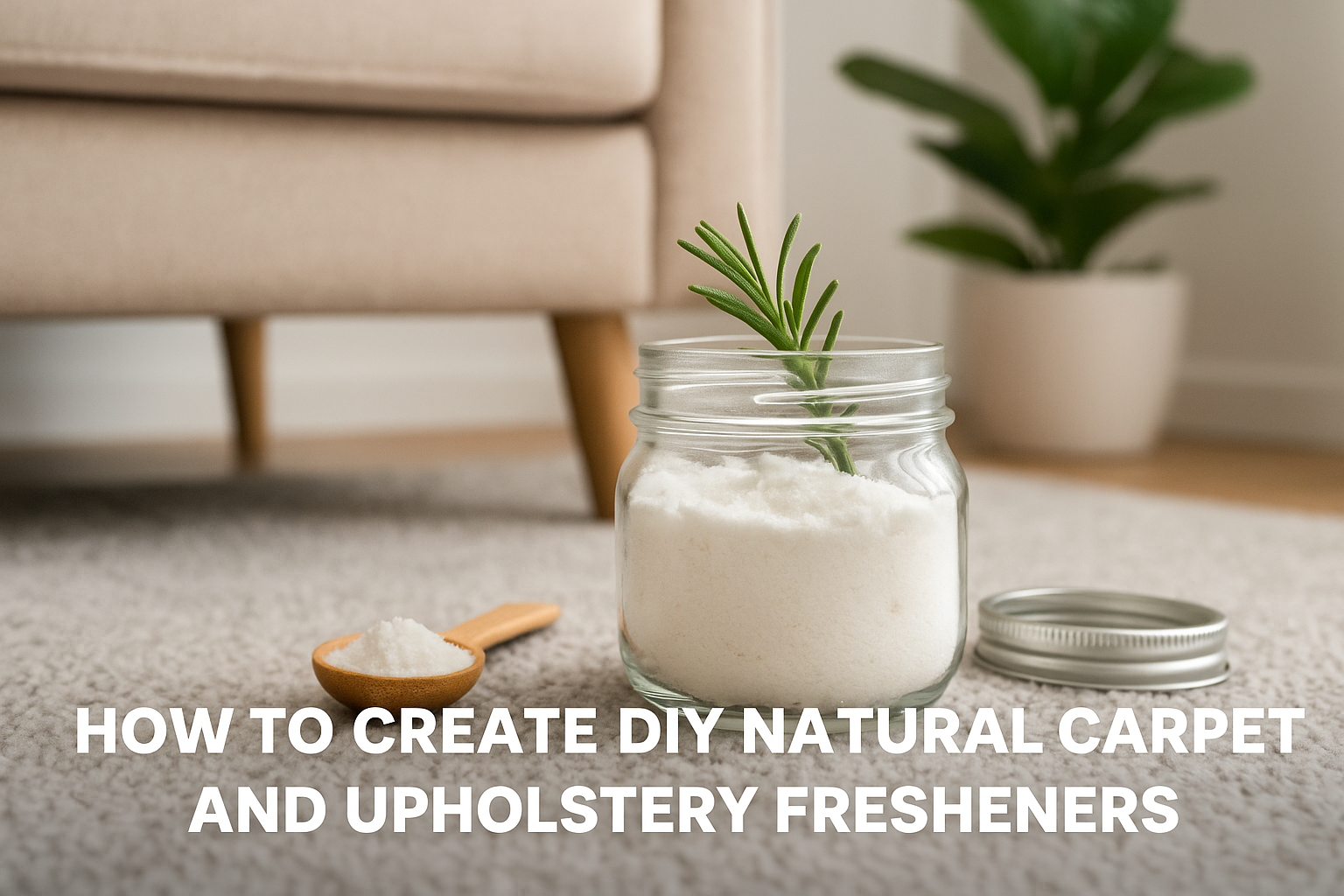Carpets, rugs, and upholstered furniture add comfort and beauty to any home. They absorb sound, soften spaces, and create a welcoming atmosphere.
But they also trap dust, odors, pet hair, and bacteria. Over time, even the cleanest-looking sofa or carpet may smell musty or look dull.
Most people turn to commercial sprays and powders, but these often contain artificial fragrances, VOCs, and chemicals that mask odors instead of eliminating them.
DIY natural carpet and upholstery fresheners are safer, cheaper, and surprisingly effective.
Using ingredients like baking soda, dried herbs, essential oils, and vinegar, you can refresh fabrics, neutralize odors, and protect your family’s health.
These recipes are easy to prepare, customizable for different needs, and environmentally friendly.
This guide explains the science behind natural fresheners, provides step-by-step recipes, seasonal variations, cleaning routines, and answers to frequently asked questions.
By the end, you will have a toolkit of natural solutions to keep carpets and upholstery fresh year-round.
Why natural fresheners work
Carpets and upholstery act like sponges. They absorb everything from cooking smells to pet dander. Synthetic sprays only mask odors temporarily. Natural solutions neutralize them at the source. Baking soda absorbs and traps smells. Vinegar breaks down odor molecules. Herbs like rosemary and marcela bring antibacterial power. Essential oils not only fragrance but also disinfect.
Benefits of DIY carpet and upholstery fresheners
They are non-toxic, safe for kids and pets. They cost very little compared to commercial products. They can be customized for fragrance and strength. They are eco-friendly, using biodegradable ingredients. They reconnect with traditional practices of cleansing spaces with herbs and natural powders.
Key ingredients
Baking soda
The foundation of most fresheners. It absorbs odors and loosens dirt.
Vinegar
Natural deodorizer and mild disinfectant.
Dried herbs
Rosemary, sage, mint, and marcela add fragrance and antimicrobial properties.
Essential oils
Lavender calms, lemon refreshes, rosemary stimulates, tea tree disinfects.
Cornstarch
Adds bulk and helps absorb moisture.
Basic powder freshener recipe
- 1 cup baking soda
- ½ cup cornstarch
- 10 drops lavender oil
- 5 drops lemon oil
Mix well and store in shaker jar. Sprinkle lightly on carpets, leave for 20 minutes, then vacuum.
Herbal carpet freshener
- 1 cup baking soda
- ¼ cup dried rosemary (crushed)
- ¼ cup dried mint
- 10 drops rosemary oil
- 5 drops peppermint oil
Freshens and disinfects naturally.
Citrus upholstery spray
- 200 ml distilled water
- 2 tbsp vinegar
- 8 drops lemon oil
- 6 drops orange oil
- 2 drops tea tree oil
Spray lightly on sofas and curtains. Test small area first to avoid staining.
Deep-clean vinegar solution
- 200 ml vinegar
- 200 ml water
- 10 drops eucalyptus oil
Wipe upholstery with cloth dampened in this solution for deep odor removal.
Seasonal variations
Spring freshness
Lavender, lemon, and mint. Light, floral, uplifting.
Summer energy
Orange, lime, and rosemary. Bright and refreshing.
Autumn comfort
Cinnamon, clove, and orange. Warm and cozy.
Winter protection
Marcela, sage, and eucalyptus. Calming and antibacterial.
Specialized recipes
Pet odor neutralizer
- 1 cup baking soda
- ½ cup cornstarch
- 10 drops tea tree oil
- 5 drops rosemary oil
Neutralizes pet smells while disinfecting.
Smoke odor remover
- 1 cup baking soda
- ½ cup coffee grounds (dried)
- 10 drops eucalyptus oil
Absorbs and neutralizes smoke from fireplaces or cigarettes.
Moisture control freshener
- 1 cup baking soda
- ½ cup cornstarch
- 10 drops lemon oil
- 10 drops lavender oil
Helps in humid climates to reduce musty smells.
How to use fresheners correctly
Sprinkle powders lightly and let sit for 20–30 minutes before vacuuming. For stronger odors, leave overnight. Sprays should be applied lightly, never soaking fabrics. Always test on hidden areas first. Repeat weekly or as needed.
Designing a natural cleaning routine
Daily
Air out rooms by opening windows. Spray light citrus or herbal blends on sofas.
Weekly
Use baking soda freshener on carpets before vacuuming.
Monthly
Wipe upholstery with vinegar solution. Replace herbal sachets in drawers or cushions.
Seasonal
Switch blends to align home energy with nature’s cycles.
Cultural roots of fabric freshening
In Gaúcho homes, herbs like rosemary and sage were burned or boiled to cleanse spaces. Marcela was used to calm and refresh linens. Citrus peels were dried and placed in drawers. Today’s DIY powders and sprays continue these traditions with modern adaptations.
Mistakes to avoid
Do not use too much essential oil; it can stain fabrics. Do not soak upholstery with sprays. Do not use baking soda on very delicate fabrics without testing. Do not expect overpowering scent; natural freshness is subtle but real.
Frequently Asked Questions
Will baking soda damage my vacuum cleaner?
No, as long as you vacuum slowly. Use small amounts and empty the bag regularly.
Can I use these sprays on all fabrics?
Most fabrics are safe, but always test a hidden area first, especially on silk or delicate upholstery.
How long do natural powders last?
About one month in sealed jars. Replace if scent fades.
Are these solutions safe for pets?
Yes, but avoid spraying directly where pets rest until dry. Use gentle oils like lavender instead of tea tree for cats.
Can vinegar leave a smell?
Yes, but it disappears quickly as it dries, leaving fabrics odor-free.
Do natural fresheners remove stains?
They are best for odors. For stains, use vinegar and baking soda paste.
How often should I freshen carpets?
Weekly for busy homes, monthly for less-used areas.
Can I combine herbs and oils?
Yes, blending dried herbs with essential oils boosts effectiveness and longevity.
Conclusion
DIY natural carpet and upholstery fresheners are simple, effective, and eco-friendly. With baking soda, vinegar, herbs, and essential oils, you can keep fabrics smelling clean without chemicals. Powders absorb odors, sprays refresh surfaces, and seasonal blends bring atmosphere to every room.
These solutions protect health, respect the environment, and continue traditions of natural home care. With just a few ingredients, you can transform your living spaces into places of comfort, freshness, and cultural meaning.

Marcela Cardozo is passionate about Southern Brazilian traditions and the cultural stories carried through natural scents. She blends knowledge of native herbs, essential oils, and regional rituals to create practical and inspiring content. Her writing connects ancestral wisdom with modern living, offering readers simple ways to bring authenticity, well-being, and meaning into their everyday lives.
